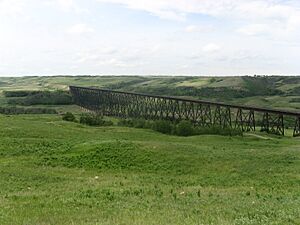Battle River facts for kids
Quick facts for kids Battle River |
|
|---|---|
 |
|

North Saskatchewan River drainage basin
|
|
| Country | Canada |
| Provinces | Alberta, Saskatchewan |
| Physical characteristics | |
| Main source | Battle Lake Alberta 849 m (2,785 ft) 52°56′57″N 114°08′41″W / 52.94917°N 114.14472°W |
| River mouth | North Saskatchewan River Battleford, Saskatchewan 463 m (1,519 ft) 52°42′42″N 108°15′13″W / 52.71167°N 108.25361°W |
| Length | 570 km (350 mi) |
| Basin features | |
| Basin size | 30,300 km2 (11,700 sq mi) |
The Battle River is an important river in Canada. It flows through central Alberta and western Saskatchewan. This river is a big branch, or tributary, of the North Saskatchewan River. The Battle River is about 570 kilometers (354 miles) long. It drains a large area of land, about 30,300 square kilometers (11,700 square miles).
Why is it Called the Battle River?
The Battle River got its name not too long ago. An explorer named Anthony Henday traveled here in the 1750s. He did not call it the Battle River.
By 1793, another explorer, Peter Fidler, called it the "Battle or Fighting River." It probably got this name because different groups of First Nations people were competing in the area. These groups included the Iron Confederacy (Cree and Assiniboine) and the Blackfoot Confederacy.
Where Does the River Flow?

The Battle River starts at Battle Lake. This lake is in west-central Alberta, near a town called Winfield. From there, the river winds its way eastward. It flows through Alberta and then into Saskatchewan.
The river finally empties into the North Saskatchewan River. This happens near the town of Battleford. Along its path, the Battle River flows near towns like Ponoka, Hardisty, and Fabyan in Alberta.
You can also find Big Knife Provincial Park along the river. This park is on the south side of the river. A famous landmark, the Fabyan Trestle Bridge, crosses the river. It's a very long bridge!
Rivers and Lakes that Join the Battle River
Many smaller rivers and creeks flow into the Battle River. These are called tributaries. Some of them are:
- Sunny Creek
- Wolf Creek
- Pigeon Lake Creek
- Stoney Creek
- Pipestone Creek
- Driedmeat Creek
- Meeting Creek
- Paintearth Creek
- Castor Creek
- Iron Creek
- Ribstone Creek
Several lakes are also connected to the Battle River. Some of these lakes are actually formed along the river itself. These include Battle Lake, Samson Lake, Driedmeat Lake, and Big Knife Lake. Other lakes, like Pigeon Lake, Coal Lake, Bittern Lake, Vernon Lake, Ernest Lake, and Soda Lake, are found in the larger area that the Battle River drains.

